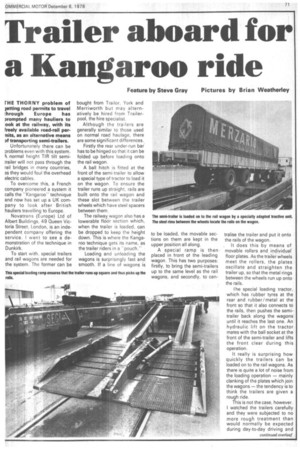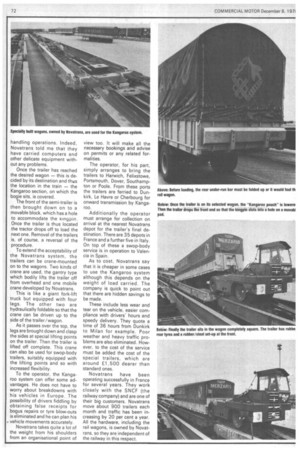Trailer aboard for a Kangaroo ride
Page 73

Page 74

If you've noticed an error in this article please click here to report it so we can fix it.
Feature by Steve Gray Pictures by Brian Weatherley
rHE THORNY problem of jetting road permits to travel through Europe has prompted many hauliers to look at the railway, with its Freely available road-rail permits, as an alternative means Pf transporting semi-trailers.
Unfortunately there can be problems even with this system.
4 normal height TlR tilt semitrailer will not pass through the rail bridges in many countries, as they would foul the overhead electric cables.
To overcome this, a French company pioneered a system it
calls the -Kangarootechnique and now has set up a UK cornpany to look after British hauliers travelling to Europe.
Novatrans (Europe) Ltd of Albert Buildings, 49 Queen Vic toria Street, London, is an independent company offering the service. I went to see a demonstration of the technique in Dunkirk.
To start with, special trailers and rail wagons are needed for the system. The former can be
bought from Trailor, York and Merriworth but may alternatively be hired from Trailerpool, the hire specialist. Although the trailers are generally similar to those used
on normal road haulage, there are some significant differences._ Firstly the rear under-run bar has to be hinged so that it can be folded up before loading onto the rail wagon.
A ball hitch is fitted at the front of the semi-trailer to allow
a special type of tractor to load it on the wagon. To ensure the trailer runs up straight, rails are built onto the rail wagon arid these slot between the trailer wheels which have steel spacers between them.
The railway wagon also has a lowerable floor section which,
when the trailer is loaded, can be dropped to keep the height down. This is where the Kangaroo technique gets its name, as the trailer riders in a -pouch."
Loading and unloading the wagons is surprisingly fast and smooth. If a line of wagons is to be loaded, the movable sections on them are kept in the upper position all along.
A special ramp is then• placed in front ot the leading wagon. This has two purposes: firstly, to bring the semi-trailers up to the same level as the rail wagons, and secondly, to cen tralise the trailer and put it onto the rails of the wagon.
It does this by means of movable rollers and individual floor plates. As the trailer wheels meet the rollers, the plates oscillate and straighten the trailer up, so that the metal rings between the wheels run up onto the rails.
the special loading tractor, • which has rubber tyres at the rear and rubber/metal at the front so that it also connects to the rails, then pushes the semitrailer back along the wagons until it reaches the last one. An hydraulic lift on the tractor mates with the ball socket at the front of the semi-trailer and lifts the front clear during this operation.
It really is surprising how quickly the trailers can be loaded on to the rail wagons. As there is quite a lot of noise from the loading operation — mainly clanking of the plates which join the wagons — the tendency is to think the trailers are given a rough ride.
This is not the case, however. I watched the trailers carefully and they were subjected to no more rough treatment than would normally be expected during day-to-day driving and handling operations. Indeed, Novatrans told me that they have carried computers and other delicate equipment without any problems.
Once the trailer has reached the desired wagon — this is de cided by its destination and thus the location in the train — the Kangaroo section, on which the bogie sits, is covered.
The front of the semi-trailer is then brought down on to a movable block, which has a hole to accommodate the kingpin. Once the trailer is thus located the tractor drops off to load the next one. Removal of the trailers is, of course, a reversal of the procedure.
To extend the acceptability of the Novatrans system, the trailers can be crane-mounted on to the wagons. Two kinds of crane are used, the gantry type which bodily lifts the trailer off from overhead and one mobile crane developed by Novatrans.
This is like a giant fork-lift truck but equipped with four legs. The other two are hydraulically foldable so that the crane can be driven up to the side of the trailer/wagon.
As it passes over the top, the legs are brought down and clasp the sides at special lifting points on the trailer. Then the trailer is lifted off complete. This crane can also be used for swop-body trailers, suitably, equipped with the lifting points and so with increased flexibility.
To the operator, the Kangaroo system can offer some advantages. He does not have to worry about breakdowns with his vehicles in Europe. The possibility of drivers fiddling by obtaining false receipts for bogus repairs or tyre blow-outs is eliminated and he can plan his , vehicle movements accurately.
Novatrans takes quite a lot of the weight from his shoulders from an organisational point of view too. It will make all the necessary bookings and advise on permits or any related formalities.
The operator, for his part, simply arranges to bring the trailers to Harwich, Felixstowe, Portsmouth, Dover, Southampton or Poole. From these ports the trailers are ferried to Dunkirk, Le Havre or Cherbourg for onward transmission by Kangaroo.
Additionally the operator must arrange for collection on arrival at the nearest Novatrans depot for the trailer's final destination, There are 35 depots in France and a further five in Italy. On top of these a swop-body service is in operation to Valencia in Spain.
As to cost, Novatrans say that it is cheaper in some cases to use the Kangaroo system although this depends on the weight of load carried. The company is quick to point out that there are hidden savings to be made.
These include less wear and tear on the vehicle, easier compliance with drivers' hours and speedy delivery. They quote a time of 36 hours from Dunkirk to Milan for example. Poor weather and heavy traffic problems are also eliminated. However, to the cost of the service must be added the cost of the special trailers, which are around £1,500 dearer than standard ones.
Novatrans have been operating successfully in France for several years. They work closely with the SNCF (the railway company) and are one of their big customers. Novatrans move about 900 trailers each month and traffic has been increasing by 20 per cent a year.
All the hardware, including the rail wagons, is owned by Novatrans, so they are independent of the railway in this respect.
































































































































